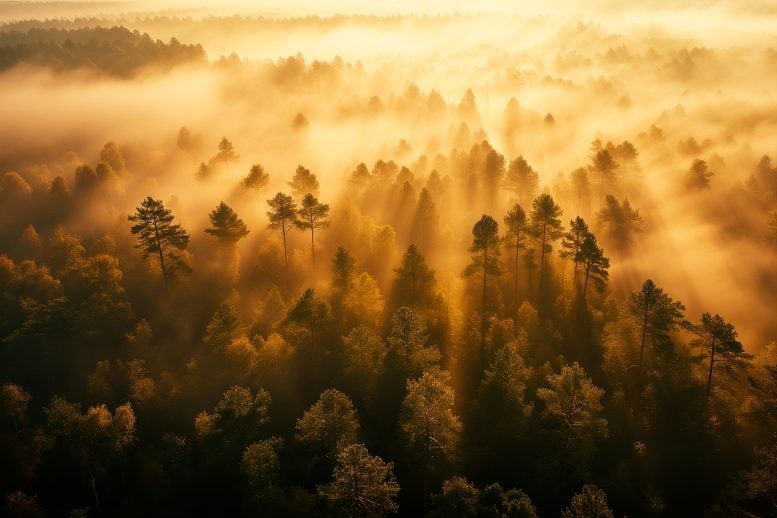
A new study shows that climate change is disproportionately affecting U.S. forests, particularly in the West, where adverse effects like reduced tree growth are prominent. This trend challenges the forests’ role as carbon sinks and highlights the urgent need for greenhouse gas emission reductions and forest conservation. Credit: SciTechDaily.com
Climate change is impacting U.S. forests, especially in the Western regions, leading to decreased tree growth and challenging their ability to act as carbon sinks.
Climate change is reshaping forests differently across the United States, according to a new analysis of U.S. Forest Service data. With rising temperatures, escalating droughts, wildfires, and disease outbreaks taking a toll on trees, researchers warn that forests across the American West are bearing the brunt of the consequences.
Study Reveals Regional Disparities in Forest Health
The study, led by UF Biology researchers J. Aaron Hogan and Jeremy W. Lichstein was published in the Proceedings of the National Academy of Sciences. The study reveals a pronounced regional imbalance in forest productivity, a key barometer of forest health that gauges tree growth and biomass accumulation. Over the past two decades, the Western U.S., grappling with more severe climate change impacts, has exhibited a notable slowdown in productivity, while the Eastern U.S., experiencing milder climate effects, has seen slightly accelerated growth.
Forests as Carbon Sinks and Climate Regulators
Forests play a critical role in regulating the Earth’s climate, acting as carbon sinks that sequester approximately 25% of human carbon emissions annually. However, their ability to store carbon hinges on the delicate balance between the positive and negative effects of climate change. The study, using national-scale forest inventory data, models trends from 1999 to 2020, analyzing 113,806 measurements in non-plantation forests.
“We are witnessing changes in forest functioning as forest ecosystems respond to global change drivers, such as carbon dioxide fertilization and climate change,” said Hogan. “It is the future balance of these drivers which will determine the functioning of forests in the coming years to decades.”
Carbon-Dioxide Fertilization and Tree Growth
Some drivers, such as droughts and forest pathogens, have negative effects on productivity, but other drivers, such as carbon dioxide fertilization, are predicted to have positive effects. This phenomenon suggests that increased carbon dioxide levels enhance plant growth by increasing photosynthesis, which inspired the researchers to take a deeper look at its impact.
“The U.S. Forest Service has been monitoring the growth and survival of over a million trees across the U.S. for multiple decades,” said Lichstein. “We were interested to see if their data provided evidence for increased rates of tree growth, as predicted by the carbon-dioxide fertilization hypothesis.”
Challenging Assumptions About Carbon Storage
While tree growth in the Eastern U.S. aligns with expectations, the Western region shows extreme climate effects overshadowing any positive growth trends, challenging the prevailing assumption that forests’ carbon-storing ability will continue to increase.
“Our study suggests that future projections of climate and sea-level rise may be too optimistic because, in reality, ecosystems are likely to store less carbon in the future,” said Lichstein. “Less ecosystem carbon storage means more carbon in the atmosphere and therefore more warming and accelerating climate change.”
Regional Variations and Climate Thresholds
The findings also illuminate the fact that climate change is not a uniform force but rather a dynamic agent with region-specific influences. The study illustrates how the degree of climate change can push forests past a tipping point. Some forests are already approaching or surpassing climate thresholds which shift them to become sources of carbon, rather than sinks that remove carbon from the atmosphere.
“Ecosystem carbon sequestration is not guaranteed to be permanent, and it can be reversed by climate change,” said Lichstein. “This reversal is already happening in the Western U.S., and there are signs that it may also be happening in other drought-impacted regions of the world, such as the Amazon.”
It might be tempting to chalk the losses up to extreme events. But, according to the researchers, the decline in productivity in the Western U.S. cannot be attributed to increased rates of tree mortality.
Decline in Tree Growth and Productivity
“We hear a lot about wildfires in the Western U.S., which kill a lot of trees and release carbon to the atmosphere,” said Lichstein. “But our study shows that additional ecosystem carbon loss in Western forests is occurring due to declining tree growth rates.”
With trees growing slower due to adverse climate change effects, including decreased precipitation, the study implies that, even without the intensifying wildfires, the carbon sink in Western forests will continue to weaken without urgent action to reduce human greenhouse gas emissions.
“We must have healthy forests in connection with emissions reduction to restore the global carbon balance and limit climate change,” said Hogan.
Urgent Need for Forest Conservation and Emissions Reduction
The transformations observed in U.S. forests raise concerns about their future resilience and sustainability. The researchers hope their findings highlight the urgent need for governments and industry to work together to reduce greenhouse gas emissions and achieve net-zero emissions as soon as possible.
“Our results highlight the need for reduced global greenhouse gas emissions,” said Lichstein. “Without the emissions reductions that scientists have been urging for decades, forest carbon sinks will likely weaken, which will accelerate the pace of climate change.”
Reference: “Climate change determines the sign of productivity trends in US forests” by J. Aaron Hogan, Grant M. Domke, Kai Zhu, Daniel J. Johnson and Jeremy W. Lichstein, 16 January 2024, Proceedings of the National Academy of Sciences.
DOI: 10.1073/pnas.2311132121
This study was developed with Grant Domke from the U.S. Forest Service Northern Research Station, Kai Zhu from the University of Michigan, and Dan Johnson from UF’s School of Forest, Fisheries, and Geomatics Sciences.









Trees breath Carbon Dioxide and Exhale Oxygen….they will recover and be more resilient than is being predicted here. 99% of all species on earth are now extinct..that goes for Trees as well. Planet is fine and will sort it out as it has done over 4.5 Billion years. People are tiny little creatures that really have no control over anything and we cannot even change one rain drop from falling. Stop hyperventilating and manage the western forests better.
Sadly, these kids have grown up playing video games inside a concrete world, not spending time in the nature learning about how Life works. They’ve been lied to about every aspect of social, econonic and natural realities for their whole lives. When “authorities” sponsor university studies by insisting on false premises, how can we trust these young people’s “conclusions”?? Use Empirical Science and follow the evidence. Stop looking only to support the sponsors agenda and determine the false facts as truth.
Can i pay you for an ad free viewing, like the nyt?
“…, the Western region shows extreme climate effects overshadowing any positive growth trends, challenging the prevailing assumption that forests’ carbon-storing ability will continue to increase.”
It should be noted that archaeological evidence shows that the SW has experienced more than one severe, very long-lasting drought, long before anthropogenic CO2 became a concern. The ecosystem survived those events. The article doesn’t make it clear that the relatively sparse tree growth of the West, compared to the dense, deciduous tree-cover of the East, is critical to the forecasts of future sequestration.
Note the contrast in two statements quoted from above:
“Our study SUGGESTS that future projections of climate and sea-level rise MAY be too optimistic because, in reality, ecosystems are LIKELY to store less carbon in the future,” versus,
“The researchers hope their findings highlight the URGENT NEED for governments and industry to work together to reduce greenhouse gas emissions and ACHIEVE NET-ZERO emissions as soon AS POSSIBLE.”
Does the cautious initial statement really support the declarative, imperative tone of the last one? I think not. They appear to have been written by two different people.